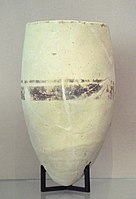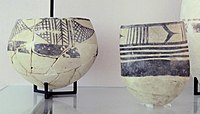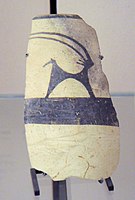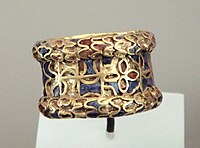Girsu (Sumerian Ĝirsu;[1] cuneiform ĝir2-suki 𒄈𒋢𒆠) was a city of ancient Sumer, situated some 25 km (16 mi) northwest of Lagash, at the site of what is now Tell Telloh in Dhi Qar Governorate, Iraq.
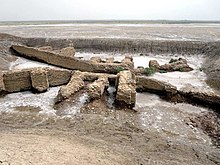 Archaeological remains of constructions at Tello/Girsu | |
| Alternative name | Tell Telloh |
|---|---|
| Location | Dhi Qar Province, Iraq |
| Region | Sumer |
| Coordinates | 31°33′43.3″N 46°10′39.3″E / 31.562028°N 46.177583°E |
| Type | Settlement |
| History | |
| Periods | Early Dynastic, Ur III |
| Site notes | |
| Excavation dates | 1929–1933, 2017 |
| Archaeologists | Henri de Genouillac, André Parrot |
History

Girsu was possibly inhabited in the Ubaid period (5300-4800 BC), but significant levels of activity began in the Early Dynastic period (2900-2335 BC). At the time of Gudea, during the Second Dynasty of Lagash, Girsu became the capital of the Lagash kingdom and continued to be its religious center after political power had shifted to the city of Lagash.[3] During the Ur III period, Girsu was a major administrative center for the empire. After the fall of Ur, Girsu declined in importance, but remained inhabited until c. 200 BC. A 4th century BC bilingual Greek/Aramaic inscription was found there.[4]
Archaeology
The site consists of two main mounds, one rising 50 feet above the plain andthe other 56 feet. A number of small mounds dot the site. Telloh was the first Sumerian site to be extensively excavated, at first under the French vice-consul at Basra, Ernest de Sarzec, in eleven campaigns between 1877 and 1900, followed by his successor Gaston Cros from 1903–1909.[5][6][7][8] Finds included an alabaster statue of a woman, with copper bracelets coated in gold and a fragment of a stone lion carved dish with a partial Sumerian inscription.[9][10] In 1879 the site was visited by Hormuzd Rassam.[11]
Excavations continued under Abbé Henri de Genouillac in 1929–1931 and under André Parrot in 1931–1933.[12][13][14] It was at Girsu that the fragments of the Stele of the Vultures were found. The site has suffered from poor excavation standards and also from illegal excavations. About 50,000 cuneiform tablets have been recovered from the site.[15] [16][17]
Excavations at Telloh resumed in 2016 as part of a training program for Iraqi archaeologists organized by the British Museum.[18][19] A foundation tablet and a number of inscribed building cones have been found. In the 5th season, in autumn 2019, work concentrated on the Mound of the Palace where E-ninnu, a temple to Ningirsu, had been found in earlier seasons.[20] In March 2020, archaeologists announced the discovery of a 5,000-year-old cultic area filled with more than 300 broken ceremonial ceramic cups, bowls, jars, animal sacrifices, and ritual processions dedicated to Ningirsu.[21][22] One of the remains was a duck-shaped bronze figurine with eyes made from bark which is thought to be dedicated to Nanshe.[23] An Indus Valley weight was also found. In February 2023, archaeologists from British Museum and Getty Museum revealed the remains of the 4,500 year-old Sumerian Lord Palace of the Kings alongside more than 200 cuneiform tablets containing administrative records of Girsu. The E-ninnu temple (Temple of the White Thunderbird), the primary sanctuary of the Sumerian warrior god Ningirsu was also identified during the excavations.[24][25]
In 2023, British Museum experts have suggested the possibility that a Greek temple at Girsu was founded by Alexander the Great. According to the researchers, recent discoveries suggest that "this site honours Zeus and two divine sons. The sons are Heracles and Alexander."[26]
Gallery
Ubaid IV artifacts (4700–4200 BC) in Girsu
- Ubaid IV pottery gobelet, 4700–4200 BC Tello, ancient Girsu. Louvre Museum.[27]
- Ubaid IV pottery jars 4700–4200 BC Tello, ancient Girsu, Louvre Museum.[28]
- Ubaid IV pottery 4700–4200 BC Tello, ancient Girsu, Louvre Museum AO 15338.[29]
- Female figurines Ubaid IV, Tello, ancient Girsu, 4700–4200 BC. Louvre Museum AO15327.[30]
Uruk Period artifacts (4000–3100)
- Uruk period vase. Terracotta, ca. 3500–2900 BC. From Telloh, ancient city of Girsu. Louvre Museum.
- Vase. Terracotta with red slip, ca. 3500–2900 BC. From Telloh, ancient city of Girsu. Louvre Museum.
- Vase. Terracotta, ca. 3500–2900 BC. From Telloh, ancient city of Girsu.
Early dynastic artifacts in Girsu (3rd millennium BC)
- Ring of Gold, Carnelian, Lapis Lazuli, Tello, ancient Girsu, mid-3rd millennium BC. Louvre Museum.
- An account of barley rations issued monthly to adults and children written in Cuneiform on clay tablet, written in year 4 of King Urukagina (c. 2350 BC). From Girsu, Iraq. British Museum, London.
- Telloh doorway erected by Gudea (c. 2100 BC)
See also

Notes
Further reading
- Barrelet, Marie-Thérèse, "Une ‘Construction Enigmatique’ a Tello", Iraq, vol. 27, no. 2, pp. 100–18, 1965
- CAUVIN, Marie-Claire, "TELLO ET L’ORIGINE DE LA HOUE AU PROCHE-ORIENT", Paléorient, vol. 5, pp. 193–206, 1979
- CROS, Gaston, "NOTE RECTIFICATIVE: SUR LE CASQUE CHALDÉEN DE TELLO: LETTRE DE M. LE COMMANDANT GASTON CROS", Revue d’Assyriologie et d’archéologie Orientale, vol. 6, no. 3, pp. 88–89, 1906
- de Vaumas, Etienne, "L’Ecoulement Des Eaux En Mesopotamie et La Provenance Des Eaux de Tello", Iraq, vol. 27, no. 2, pp. 81–99, 1965
- DANGIN, François THUREAU, "NOTICE SUR LA TROISIÈME COLLECTION DE TABLETTES: DÉCOUVERTE PAR M. DE SARZEC A TELLO", Revue d’Assyriologie et d’archéologie Orientale, vol. 5, no. 3, pp. 67–102, 1902
- Donbaz, Veysel, and Foster, Benjamin R., "Sargonic Texts from Telloh in the Istanbul Archaeological Museum", Occasional Publications of the Babylonian Fund 5, Philadelphia: The University Museum, 1982 ISBN 9780934718448
- [4]Chiera, Edward, "Selected temple accounts from Telloh, Yokha and Drehem", University of Pennsylvania, 1921
- Harriet Crawford, 'The Construction Inférieure at Tello. A Reassessment', Iraq, vol. 49, pp. 71–76, 1987
- Benjamin R. Foster, 'The Sargonic Victory Stele from Telloh', Iraq, Vol. 47, pp. 15–30, 1985
- Foster, Benjamin R., "Sargonic Texts from Telloh in the Istanbul Archaeological Museums, Part 2", ISD LLC, 2018 ISBN 9781948488082
- de GENOUILLAC, H., "RAPPORT SUR LES TRAVAUX DE LA MISSION DE TELLO: II E CAMPAGNE : 1929—1930", Revue d’Assyriologie et d’archéologie Orientale, vol. 27, no. 4, pp. 169–86, 1930
- Leon Heuzey, "MISSION FRANÇAISE DE CHALDÉE: REPRISE DES FOUILLES DE TELLO", Revue d’Assyriologie et d’archéologie Orientale, vol. 6, no. 1, pp. 1–4, 1904
- Laurito, Romina, "Clay sealings from Telloh: new evidence from a 3rd millennium BC "corpus"", Pathways through Arslantepe. Essays in Honour of Marcella Frangipane, hrsg. v. Balossi Restelli, Francesca, 2020
- Claudia E. Suter, 'A Shulgi Statuette from Tello', Journal of Cuneiform Studies, vol. 43/45, pp. 63–70, (1991–1993)
- PARROT, André, "LES FOUILLES DE TELLO ET DE SENKEREH-LARSA: CAMPAGNE 1932-1933 (Rapport Préliminaire)", Revue d’Assyriologie et d’archéologie Orientale, vol. 30, no. 4, pp. 169–82, 1933
- PARROT, André, "FOUILLES DE TELLO: CAMPAGNE 1931-1932 (Rapport Préliminaire)", Revue d’Assyriologie et d’archéologie Orientale, vol. 29, no. 2, pp. 45–57, 1932
- [5]Sébastien Rey, 'Divine Cults in the Sacred Precinct of Girsu', Near Eastern Archaeology; Chicago, vol. 84, iss. 2, pp. 130-139, June 2021
- Sébastien Rey, "For the Gods of Girsu: City-State Formation in Ancient Sumer", Archaeopress Archaeology, 2016 ISBN 978-1784913892
External links
- Getty Girsu Project
- The British Museum’s Heritage Initiative is helping to uncover remains of a lost palace in Iraq - UK Daily - 17 February 2023
- 5,000-year-old artifacts unearthed in Sumerian city of Girsu in Iraq - Daily Sabah - Nov 17, 2021
- Fragment of a stone plaque depicting Enannatum found in Tello (Girsu), from the collection of the British Museum, on the site of Google Cultural Institute
- Images of Girsu - Oriental Institute of the University of Chicago
- Stele of the Vultures at the Louvre
- The world's oldest bridge is being preserved in Iraq
- The Iraq Emergency Heritage Management Training Scheme: an update
- Excavations at Girsu Video - British Museum

